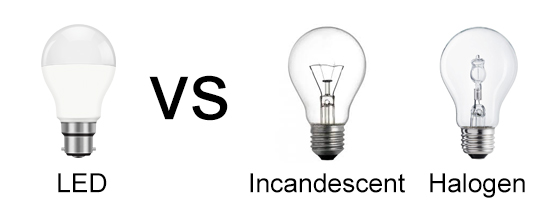There are many different types of lighting technologies to choose from. Knowing the difference between incandescent and LED and the difference between halogen and LED can help you make an educated decision on what’s best for your application and budget.
Incandescent:
This well-known lighting type is the most dated and least efficient. Much like in a space heater, an electric current passes through thin filament wire, which heats the filament until it glows. Heat radiates outward from the space heater as it does in an incandescent bulb, and only a small portion of the energy created is converted into usable light; the considerable amount of heat burns the bulb’s tungsten filament until it breaks.
What you should know:
- Incandescent bulbs use—at most—10 percent of the energy they consume to make visible light; the other 90 percent is wasted heat.
- They produce a considerable amount of infrared (IR) and ultraviolet (UV) radiation that can be damaging to fabrics and artwork.
- They’re designed to last just 1,200 hours.
- Incandescent bulbs have a fragile glass envelope and brittle filament wire.
- These bulbs are relatively cheap but consume so much energy that standard 40- and 60-watt options are no longer available for purchase in the U.S.
- They create a warm yellow light.
|

|
Halogen:
Halogen bulbs are similar to incandescent bulbs but with a couple minor differences. They contain a tungsten filament, but unlike in incandescent bulbs, a small amount of halogen gas mixes with tungsten vapor and deposits it back onto the filament instead of on the inside of the bulb envelope. This process extends the bulb’s lifespan and allows it to work at a much higher temperature than incandescent bulbs, which increases light output. A quartz envelope is used instead of glass because of its ability to handle higher temperatures.
What you should know:
- Halogen bulbs come in many shapes but are commonly used as PAR, BR, AR, and MR spotlight or flood light bulbs.
- They produce a considerable amount of infrared (IR) and ultraviolet (UV) radiation that can be damaging to fabrics and artwork.
- These bulbs require an extremely hot running temperature to produce light and can cause burns if touched; the high temperature also prevents these bulbs from functioning as well in cold environments.
- Halogen bulbs are extremely sensitive to skin oils, which can cause them to malfunction or burst.
- They last approximately 3,600 hours—three times longer than incandescent bulbs—but are not as efficient as compact fluorescent lamps (CFL) or LED bulbs.
- Halogen bulbs have a fragile quartz envelope and brittle filament wire.
- Because they operate at higher temperatures, halogen bulbs have higher color temperatures and produce brighter light than incandescent bulbs.
|

|
Light-Emitting Diodes (LEDs):
LEDs produce the longest-lasting, most energy-efficient lighting available today. A semiconductor rich in electrons and a semiconductor rich in holes are used to create an LED. Passing a current through the junction of these two materials combines the electrons with the holes and produces photons, which is the light that you see. LEDs have endless application possibilities, such as under-cabinet, landscape, vehicle, work, home, industrial, and commercial lighting.
What you should know:
- LEDs run much cooler than incandescent and halogen bulbs, which greatly increases their longevity and enables them to function in cold temperatures.
- Unless an LED is specifically infrared (IR) or ultraviolet (UV), it produces little to no IR or UV radiation, which can be damaging to fabrics and artwork.
- They can last up to 50,000 hours—42 times longer than incandescent bulbs and 13 times longer than halogen bulbs.
- Power consumption is the lowest compared to all other lighting technologies—80 percent less than incandescent bulbs and 75 percent less than halogen bulbs.
- The shatterproof bulbs are shock resistant and have no brittle filaments.
- LEDs require higher initial investment but produce greater energy returns over time.
- LEDs contain no mercury, harmful gasses, or toxins.
- They are available in many different whites and colors.
- Because of their low power consumption, LEDs are great alternative lighting solutions for solar-powered systems
|

|







